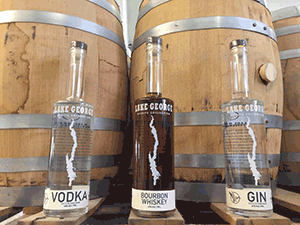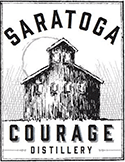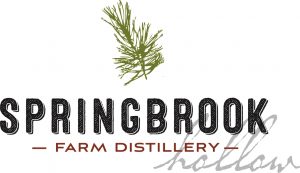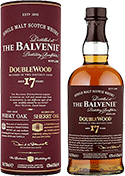 Lake George Distilling Company was founded in 2012. We took our love of quality hand crafted spirits and decided to create our own. We take the time to select the best local ingredients from the region and use them to hand craft our spirits in small batches. We hope you will enjoy our products as much as we enjoyed creating them for you.
Lake George Distilling Company was founded in 2012. We took our love of quality hand crafted spirits and decided to create our own. We take the time to select the best local ingredients from the region and use them to hand craft our spirits in small batches. We hope you will enjoy our products as much as we enjoyed creating them for you.
- Vodka

- Bourbon Whiskey
- Gin
- Rum


Pick Six Vodka
Saratoga's award winning vodka.
The Pick Six name and imagery is steeped in the rich history of Saratoga Springs. Created using a non-GMO, neutral grain spirit that is six times distilled and naturally gluten free. We use an all natural water supply drawn from the well on our property to produce the finest, cleanest spirit money can buy.
Pick Six has been awarded a gold medal at the Denver International Spirits Competition, a silver medal at the New York International Spirits Competition, and a bronze medal at the Berlin International Spirits Competition.
Pick Six named 2014 Vodka of the Year.

Devils Den Apple Pie Moonshine
Devils Den dubbed "moonshines for the rest of us" are not your typical "rock gut" moonshines. The Apple Pie is a subtle blend of NY apple and cinnamon flavors for a semisweet, but not overpowering taste. Enjoy straight, on the rocks or with your favorite seasonal mixer. It pairs superbly with apple cider and cranberry juice.

Devils Den Strawberry Jam Moonshine
The Strawberry Jam is inspired by fields next to the distillery and comes together in extraordinary blend of strawberry flavors. Enjoy straight, on the rocks or with your favorite seasonal mixer. It's Exceptional with club soda, lemonade or even added to your favorite stout beer.
 Our Farm Distillery is located in Springbrook Hollow, nestled within the Foothills of the Adirondack Mountains. Our mission is to produce hand crafted, high quality spirits using local grains and fruits in a natural and innovative process. For more information about Springbrook Hollow Click Here.
Our Farm Distillery is located in Springbrook Hollow, nestled within the Foothills of the Adirondack Mountains. Our mission is to produce hand crafted, high quality spirits using local grains and fruits in a natural and innovative process. For more information about Springbrook Hollow Click Here.
- Two Sisters Orangecello
- Two Sisters Lemoncello
- Two Sisters Vodka
- Adirondack High Rye Bourbon
- Sly Fox Gin
- Pumpkin Pie Moonshine
- Apple Moonshine
- Basil Hayden

- Jim Bean
- Jim Bean Rye
- Bootlegger
- Bulleit Bourbon
- Bulleit Rye
- Jim Bean Apple
- Jim Bean Vanilla
- Jim Bean Fire
- Barenjager
- Korbel

- E & J
- Hennessy

- Bols Genever

- New Amsterdam
- Bootlegger
- Brokers
- Gilbey's
- Beefeater
- Hendricks
- Tangueray
- Bombay Sapphire
- Skol
- Caravella Limoncello

- McCormick Irish Creme
- Pimm's
- Cointreano
- Fratello Hazelnut
- Galliano
- Grand Marier
- Irish Mist Honey
- Jaggermeister
- Rumple Minze
- Black Haus
- Midori Melon
- Tia Maria
- Kahlua Coffee
- Bailey's Irish Creme
- Sabrossa Licor de Cafe
- Malibu

- Bluechair Bay
- Conch Republic
- The Kraken
- Captain Morgan
- Bacardi
- Myer's Rum
- Ty Ku

- Romana Sambvca

- Romana Black
- 1800 Reposada

- Maestro Dobel
- Patron Silver
- Jose Cuervo
- Jose Cuervo Tequila Silver
- Rancho Alegre Tequila Blanco
- Rancho Alegre Tequila Reposada
- Martini & Rossi

- Three Olives

- Grey Goose
- Bootlegger
- Davids Harp
- Razul
- Tantero
- Smirnoff
- Titos Handmade
- Ketel One
- Stolichnaya
- Stoli Vanilla
- Stoli Orange
- Svedka
- Svedka Blue Raspberry
- Absolute
- Absolute Vanilla
- Absolute Lime
- Fire Fly
- Deep Eddy Vodka
- Deep Eddy Orange
- Deep Eddy Ruby Red
- Deep Eddy Lemon
- Skol
- Crystal Palace Deluxe
- Eagle Rare

- 1792
- Woodford Reserve
- Knob Creek
- Black Velvet
- Kentucky Gentleman
- Diseromo
- Jack Damiels
- Makers Mark
- Defiant
- Fireball
- Chivas Regal
- Talisker
- The Macallan 12 Years Old
- The Macallan 18 Years Old
- The Macallan 21 Years Old
- The Distillers Edition Dalwhinne
- The Glenlivet 18 Years of Age
- The Glenlivet 15 Years of Age
- The Glenlivet 12 Years of Age
- Lagavulin Aged 16 Years
- The Balvenie Aged 12 Years
- The Balvenie Aged 14 Years
- The Balvenie Aged 17 Years
- The Balvenie Aged 21 Years
- Glenfiddich Aged 12 Years
- Glenfiddich Aged 18 Years
- Glenfiddich Aged 21 Years
- Dewar's
- Inver House
- Seagram's VO Gold
- Canadian Club
- Crown Royal
- Crown Royal Regal Apple
- Black Velvet
- Seagram's 7
- Southern Comfort
- Jameson
- Bushmills
- Clan McGregor
- Tullmore Dew
